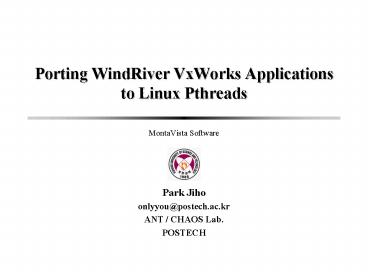Porting WindRiver VxWorks Applications to Linux Pthreads - PowerPoint PPT Presentation
1 / 17
Title:
Porting WindRiver VxWorks Applications to Linux Pthreads
Description:
Reasons for Porting VxWorks Application to Linux. Steps in Porting from VxWorks ... Low development cost and royalty free product. Project Parts. Linux Porting ... – PowerPoint PPT presentation
Number of Views:323
Avg rating:3.0/5.0
Title: Porting WindRiver VxWorks Applications to Linux Pthreads
1
Porting WindRiver VxWorks Applicationsto Linux
Pthreads
- MontaVista Software
2
Contents
- Projects Outline
- TMS (Tornado for Managed Switches)
- TMS Architecture
- Standard Porting Configuration
- Reasons for Porting VxWorks Application to Linux
- Steps in Porting from VxWorks to Linux
- System Calls Not Addressed
- Caveats when Porting VxWorks Application to Linux
3
Project Outline
- Code Name LSP (Linux Switch Package)
- Objective
- Develop a LAN switch package on Linux (LSP). LSP
is small enough to fit on custom fresh memory,
support RFCs related with LAN switching - Significance
- Low development cost and royalty free product
- Project Parts
Linux Porting
- VLAN, STP, IGMP?? Linux implementation?
- ??
- - TMS 2.0? Linux? Porting ? ??
- Hardhat? Porting VxWorks Application to Linux
- ? ?? ??? ??
- - ?????? ?? ????? ?? ??? ??
Internetworking Protocol
Network Management
4
TMS (Tornado for Managed Switches)
5
TMS Architecture
6
Standard Porting Configuration
7
Reasons for Porting VxWorks Application to Linux
- Price
- Stability
- Open-source architecture
- Standard interfaces
- Networking support
- The wide range of supported peripheral devices
- Large bodies of existing legacy code developed
for the VxWorks platform
VxWorks virtual machine
which implement most of the core feature of the
Vxworks kernel on a standard Linux platform
8
Steps in Porting from VxWorks to Linux
- Two main steps to port VxWorks code to Linux
pthreads
9
Steps in Porting from VxWorks to Linux (Cont.)
- Example header files and demonstration programs
are available on the MontaVista FTP site at
ftp.mvista.com/pub/v2linux/ - in the tar file, v2linux.tgz.
10
Steps in Porting from VxWorks to Linux (Cont.)
- This step will usually consist of generating a
GNU C and/or C compiler, assembler, and linker
for the desired target CPU.
11
Steps in Porting from VxWorks to Linux (Cont.)
- The Linux kernel and an application-dependent
subset of available daemons and system utilities
must be ported to the target hardware. - A requisite set of device drivers must also be
generated.
12
Steps in Porting from VxWorks to Linux (Cont.)
- This will involve (at a minimum) the resolving of
differences in header file contents and location,
as well as function prototypes and word-length
issues.
13
Steps in Porting from VxWorks to Linux (Cont.)
- These unresolved references will generally be due
to functions present in the legacy RTOS
environment which have not been duplicated in the
Linux virtual machine.
to extend the virtual machine environment by
implementing the referenced RTOS functions, to
substitute a native Linux function whose
functionality approximates that of the missing
RTOS function, or to re-code the application in
such a way as to eliminate the need for the
missing RTOS function.
14
Steps in Porting from VxWorks to Linux (Cont.)
- Most C code contains what might be considered
abuses of the language, and these create problems
when porting the code. - Programming tricks which enhance performance or
facilitate coding in one environment often break
the code when transported to another compiler or
CPU architecture.
Ex) integer ranges, endian-ness,
internal layout of structure
15
Steps in Porting from VxWorks to Linux (Cont.)
- Enhancing Efficiency of the VxWorks Virtual
Machine Code - Eliminating Bulletproofing Code After
Application Testing - Adapting VxWorks Code to Native Linux Code
- Re-coding Frequently-called Functions in Assembly
Language
16
System Calls Not Addressed
- filesystem and networking component features
- multiple-processor architectures
- target-level debuggers or board support packages
17
Caveats when Porting VxWorks Application to Linux
- Linux and most other Unix-type operating systems
were never designed to support the requirements
of hard real-time systems, where deterministic
and predictable response times for a real-world
event are required - Support of hard real-time features requires an
adapter layer of code which adds functionality
at the inevitable expense of raw performance. - Some VxWorks features, such as user hook routines
at task-switch time, cannot be readily
implemented in a Linux environment without
resorting to kernel modification. - An additional caveat regarding the Linux
environment regards the possibility of
encountering library functions which are not
thread-safe or reentrant.































